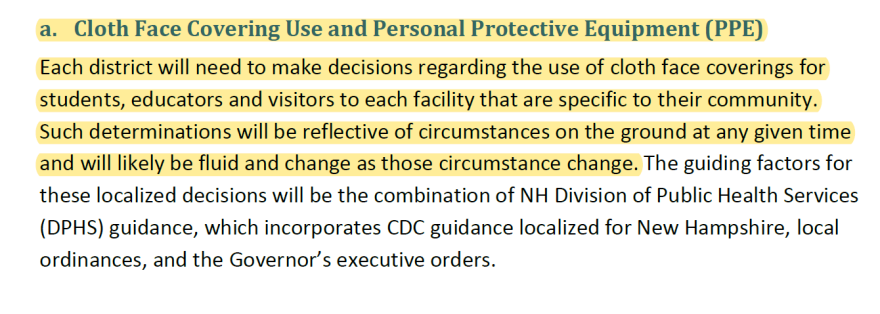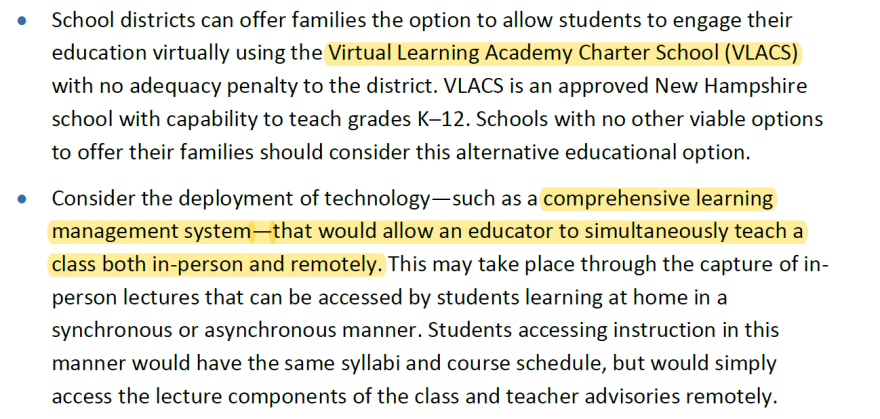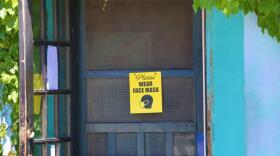Gov. Chris Sununu’s guidelines for reopening New Hampshire schools call for in-class instruction in most circumstances, but leave major decisions for how to resume teaching during the pandemic to local districts.
The 54-page guidance document released Tuesday combines recommendations from the New Hampshire health department with input by the New Hampshire Education Commissioner Frank Edelblut and a state task force on school reopening and redesign. Sununu said the guidelines are designed to keep students safe and to give districts flexibility to reopen based on local conditions.
Support NHPR's reporting by becoming an NHPR member today.
“What we didn’t want to do at the state level is say, ‘You must adhere,’ and have those certain circumstances where it just wasn’t possible, and then those districts come back and say, ‘I guess we have to close; there’s no way to manage what you’ve mandated,’ ” Sununu said at a press conference Tuesday. “That's the rigidity we have tried to remove from the system.”
Minimal Requirements for Masks
The new guidance says masks should be required for all outside visitors in a school building. For everyone else, masks are optional.
Cloth face coverings for teachers are “strongly encouraged,” and students should only have to wear face coverings when they can’t maintain social distancing, such as at bus stops, classroom entrances, or in hallways.

The state says schools should provide PPE to staff who will be in close contact with students, such as nurses, special education teachers and paraprofessionals. The state will help facilitate PPE purchases, but it’s up to districts to pay for it.
Recommendations for Enhanced Sanitation and Social Distancing
The guidance directs schools to institute daily health screenings for all students and staff.
It discourages congregating outside of the classroom – including at recess and lunch - and says students should maintain social distance of at least three feet when possible. That’s less than the six feet recommended by the CDC, but there is some data suggesting that three feet reduces transmission of COVID-19.
The guidelines also encourage the use of assigned seats in classrooms and on busses.
Although some New Hampshire schools are offering classes in-person this summer and many daycares have reopened, there are still many questions about transmission of the virus in enclosed spaces.
To encourage air circulation in buildings, the state says schools should ensure HVAC and ventilation systems are working properly. If possible, school bus windows should remain open and hand sanitizer should be made available on the bus.
But on many matters, the guidance makes clear that individual school districts will have to decide on their own whether stricter rules are necessary to reduce the risk of transmission. That includes questions like whether to require face masks for students, reduce the number of students on buses, or opt for a hybrid model of virtual and in-person learning to minimize the number of students in school at one time.
Sununu said the state Department of Education will investigate if schools are operating unsafely, though with so few reopening requirements, it is unclear what rules the state would enforce.
“If there are cases where a school or district is repeatedly violating something, then we’ll work with those school districts to find out: why is that happening, what isn’t working. We’re not just going to go in and say: ‘You have to shut down,’ ” Sununu said. “This is all about flexibility.’
Flexibility Means Major Decisions Ahead for School Boards
State epidemiologist Benjamin Chan said the current COVID-19 infection numbers in New Hampshire, which have remained relatively steady for several weeks, bode well for schools reopening. But he said districts should brace for changes as the pandemic continues.
“What things will look like in New Hampshire come fall time is up in the air, but schools need to be planning for all eventualities,” said Chan.
This means preparing for multiple teaching scenarios: in-person instruction, a hybrid model that combines in-person and remote instruction, and fully remote instruction.
Many districts are already weeks into planning for these. Merrimack, Bedford, Nashua, and Manchester have indicated that a hybrid model is likely. SAU 39, in Amherst, hopes to offer full-time in-person instruction as well as remote options to “all students and staff who choose it.”
Sununu suggested he was unlikely to re-issue the kind of executive order that shut down schools statewide in March.
“The threshold to return to the statewide remote learning is extremely different now,” he said, pointing to greater knowledge of COVID-19 and how it spreads, as well as improved access to testing and PPE.
This leaves it up to local school boards and administrators to work with public health officials to assess risk and determine when to go remote.
Gorham superintendent David Backler said classes there will go into short-term remote instruction if the number of active infections rises in Coos County rises above 20. Otherwise, the majority of students and staff will be headed back to school with new protocols to reduce risk.
“You can’t guarantee that nothing is going to happen. Just like I can’t guarantee that no one will get the flu or that no one will get head lice,” Backler said. “But you can look in the science and say ‘these numbers are low enough in our area that it’s not a significant risk.”
Backler welcomed the state’s new guidance, saying it allowed North Country districts to resume school based on local conditions rather than infection rates in the southern tier.
But Barrett Christina, director of the New Hampshire School Boards Association, warned that so much regional variation could make for a chaotic school year.
“While honoring local control is the New Hampshire tradition, consistency among school districts can help ease some of the public and parents’ concerns about reopening,” he said.
Anticipated Costs of Reopening During the Pandemic
To open safely, districts expect to spend more on busing, personal protective gear like masks and gloves, cleaning supplies and staff. They will likely need to hire more substitutes when teachers are out because of COVID-19 symptoms or infection. And they will need more nurses and bus drivers, already in short supply in New Hampshire.
If they go remote again, schools could save on facility, custodial, and transportation costs, but they will likely have to spend more on professional development and technology for students and teachers to connect virtually.
While some districts saw net savings during school closure this spring, towns and school budgets are preparing for steep cuts amid the economic downturn.
Sununu said districts can pay COVID-related expenses with federal relief money from the CARES Act. Districts have until September 2021 to spend that money, but some are planning to use it to cover costs from remote learning earlier this year.
Teachers Push For Stricter Safety Requirements
According to the NEA-NH, the state’s largest teachers’ union, over 3,000 New Hampshire teachers are considered “high-risk” because they are over 60 years old; many others have underlying health conditions that put them in this category, as well.
In a statewide survey conducted by the state Department of Education this spring, about 80 percent of teachers said they were likely to return to school if it reopened in the fall. But nearly the same amount also said they were concerned about their health and safety upon returning to school.
“How to bridge that dichotomy between those two statements is certainly the challenge,” said Christina, who also served on the statewide task force for reopening and redesigning schools. “If you have an older teacher who is two years from retirement, who may have underlying health conditions, is that individual going to be eager to go back into the school building? Or is that person going to be able to take extended leave?”
The state’s guidance acknowledges that some teachers will have to stay remote next year for these very reasons, and it says districts must work to accommodate them.

Megan Tuttle, president of the NEA-NH, condemned the guidance, saying it was full of recommendations rather than requirements that would ensure safety.
“No student or educator should be allowed back into any school building if the school district has not designed or implemented classroom, bus, and hallway layouts that accommodate six feet of distancing,” she wrote in a press release on Tuesday.
The NEA-NH says in addition to the six-feet requirement, all students above second grade should be required to wear masks, and HVAC systems should be updated if necessary.
Guidance Gets Mixed Reaction Among Parents
On social media, parents reacted with a mixture of relief and anxiety to the state guidance. Some said the benefits of a return to classrooms far outweighed the risks; others feared that the state’s flexibility would allow districts to cut corners and not meet public health standards.
This tension is reflected in surveys conducted by the state Department of Education, which found that nearly 70 percent of parents are likely to send their children back to school, while 13 percent are not.
On Tuesday, Sununu stressed that all students have the right to an education and that parents should work with their local school districts to develop a plan for remote learning if that’s preferred or necessary to keep their families safe.

Most districts expect to announce their reopening plans in the first half of August.
______________
COVID and The Classroom: NHPR wants to understand how this unusual school year is playing out across the state. Every few weeks, we'll ask you to answer a new question. The latest: How has going back to school been different for you this year? Give us a few examples here to help us tell the story.









